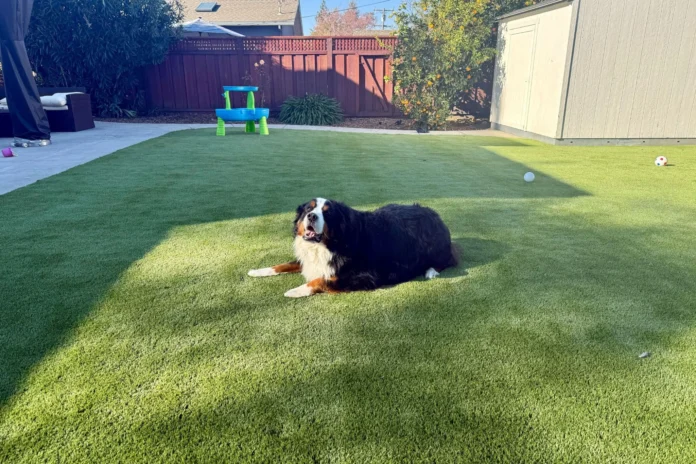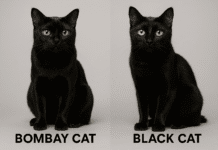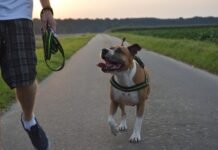Table of Contents
Key Takeaways
- Artificial grass provides a mud-free, low-maintenance solution for pet owners, ensuring cleaner homes throughout the year.
- Quality synthetic turf is designed for pet comfort and ease of cleaning, making it a practical alternative to real lawns.
- Switching to artificial turf helps conserve water, withstands heavy pet use, and can help reduce allergies for both pets and people.
- Installation requires thoughtful planning, but the long-term benefits make it a worthwhile investment for many households with dogs.
Pet-Friendly Advantages of Artificial Turf
Dogs are notorious for transforming lush yards into landscapes dotted with bald patches and muddy craters. Every pet owner knows the frustration of watching a well-maintained lawn succumb to daily games of fetch or digging. Traditional grass struggles to recover from this constant abuse, resulting in additional maintenance costs and dirty paws coming back inside. With pet-friendly artificial turf solutions, that picture changes dramatically. These synthetic lawns are engineered to withstand the wear and tear of energetic dogs, keeping yards looking vibrant and inviting all year, regardless of the weather. By eliminating the muddy patches and standing water, artificial turf keeps both your pets and your home cleaner, saving time on both yard repairs and interior cleaning.
Real-life feedback reveals just how noticeable the change can be. Many owners no longer dread rainy days or worry about mud tracked through the house. Some even report their dogs spending more time outside, enjoying a dry and consistently green surface. As highlighted by Turf Magazine, homeowners see immediate improvements in both the appearance and usability of their yards. Gone are the headaches of bare spots and the seasonal scramble to reseed or repair.
Maintenance Tips for Synthetic Lawns
Maintaining a lush, vibrant, and natural lawn can often feel like a demanding part time job, especially with energetic dogs joyfully romping around. The tasks of mowing, weeding, watering, and reseeding all require consistent and regular attention, not to mention t he added challenge of managing unsightly brown spots and the inevitable damage caused by pets. By contrast, opting for synthetic turf dramatically simplifies the process of pet yard care to a few straightforward and uncomplicated steps. Routine maintenance generally entails diligently removing solid waste every day, as well as rinsing off any liquid messes with a garden hose for optimal cleanliness. For most pet owners, this process is not only simpler but also significantly reduces the time required to keep everything neat for their furry companions.
Moreover, synthetic turf effectively eliminates any risk of pets coming into direct contact with potentially harmful fertilizers, pesticides, or herbicides that are typically used on natural grass lawns. The routine maintenance of synthetic turf includes brushing the turf fibers to maintain an appealing, natural look and applying pet-safe enzyme cleaners as needed to break down organic waste, ensuring a clean and healthy environment for pets.
In high-traffic areas or homes with multiple pets, regular brushing becomes essential to ensure that the fibers remain upright, resulting in a consistently soft, resilient, and enjoyable play surface for pets and their owners. Some owners even find great comfort in knowing that their yard will always be ready to entertain guests or family, even after a sudden and unexpected downpour, without the usual concerns of muddy paw prints or uneven grass. The convenience offered by synthetic turf makes it an appealing choice for homes with pets.
Managing Pet Odors on Artificial Grass
Odor control is a prevalent and significant concern among pet owners who are considering the installation of artificial turf in their homes or outdoor spaces. Modern innovations in synthetic turf options are specifically designed with fast-draining backings that aim to help eliminate not only urine but also lingering moisture that can often be a challenge when dealing with standard natural grass. However, it is important to note that ongoing odor management remains a crucial key to maintaining the inviting nature of outdoor spaces. Most unpleasant odors can be effectively kept at bay with routine rinsing and diligent removal of pet waste, which is essential for maintaining a clean environment.
For added support in managing odors, many advanced synthetic turf systems utilize specialized infills, such as antimicrobial sand or specially designed odor-absorbing granules, which are specifically designed to tackle unpleasant smells at their source. Consistent cleaning practices—especially after periods of heavy use or particularly warm days—are crucial in maintaining the turf in optimal condition. Reputable resources, such as Good Housekeeping, recommend using gentle, pet-safe cleaners in conjunction with regular rinsing to keep surfaces fresh and odor-free. Additionally, creating and adhering to a regular cleaning schedule can make a significant difference in maintaining cleanliness and preventing potential issues from developing in the future.
Environmental Impact and Sustainability
Lawn care consumes significantly more resources than most people truly realize or appreciate. According to extensive research conducted by the Environmental Protection Agency (EPA), outdoor irrigation accounts for nearly one-third of all residential water usage—amounting to close to an astonishing nine billion gallons every single day—all of which supports the maintenance of traditional lawns. In stark contrast, the use of artificial turf for pets significantly reduces this figure, requiring little to no water beyond the occasional rinse to maintain its appearance.
Furthermore, the environmental benefits associated with synthetic lawns extend beyond water conservation. Artificial lawns do not require chemical fertilizers or various pest control products, which effectively reduces the amount of harmful chemical runoff into local streams, rivers, and the surrounding soil. Modern artificial grass is expertly designed to last for many fruitful years, and a growing number of these products can be recycled at the end of their useful lifespan. Artificial lawns are becoming increasingly attractive to eco-conscious pet owners who seek sustainable solutions with a positive environmental impact over the long term. It serves as a practical and efficient answer to the pressing question of how to maintain a lush, green yard without sacrificing environmental responsibility or sustainability in the process.
Health and Comfort for Dogs
Dogs thrive in spacious and open environments where they can freely run, dig, and enjoy relaxing naps in absolute comfort. The ideal outdoor environment that caters to their needs must be safe, soft, and entirely free from potential hazards that could pose a threat to their well-being. Pet-specific synthetic turf is thoughtfully constructed using non-toxic, lead-free materials that prioritize safety, featuring soft fibers designed to prevent irritation to sensitive skin or delicate paws. Because there’s significantly less mud and far fewer weeds in these synthetic environments, dogs are far less likely to pick up allergens, fleas, or ticks that are commonly associated with natural grass surfaces.
Many attentive pet owners observe that their dog’s allergy symptoms—such as itchy paws, relentless licking, and periodic sneezing—tend to lessen or even disappear after making the switch to artificial turf. Additionally, with innovative features such as advanced cooling infills and antimicrobial coatings, artificial grass now offers a safe and comfortable environment for dogs to play and rest, even in the scorching summer months. The easy cleaning process associated with this type of turf means a considerably reduced risk of bacteria building up on the lawn. For families that include puppies, elderly dogs, or pets with various sensitivities, maintaining a consistently clean and well-cared-for turf can contribute to healthier skin and result in fewer trips to the veterinarian, ultimately enhancing the overall happiness and well-being of the pet.
Cost Considerations: Synthetic vs. Natural Lawns
The idea of investing in artificial turf may give some dog owners pause and cause them to contemplate the implications carefully. Still, it’s essential to take a long-term view in this situation. Traditional lawns require ongoing purchases of various supplies such as seed, fertilizer, and weed control products—not to mention the considerably higher water bills, the regular maintenance of tools, or the substantial costs associated with repairing pet damage that occurs over time. Over several years, these small expenses can accumulate quickly and have a significant impact on a budget. In contrast, synthetic lawns typically pay for themselves within a period of five to eight years, thanks to drastically reduced upkeep requirements and much lower water use compared to natural grass.
Additionally, synthetic turf offers a level of predictability in terms of both budgeting and yard appearance that many homeowners find appealing. Owners no longer have to factor in extra costs for seasonal repairs or unexpected damage that can arise from weather or pet activity. Whether it’s rain or shine, heavy use or drought conditions, the turf holds its vibrant color and durable structure, effectively sparing owners the usual stress associated with seasonal brown spots or rapid wear of a natural lawn. For those who genuinely value both time and money in their landscaping efforts, the overall equation often tips in favor of choosing artificial turf once all variables and considerations are thoughtfully examined and weighed.
Steps for Installing Artificial Turf for Pets
- Begin by clearing the area of existing grass, rocks, and debris to provide a smooth base for installation.
- Level and compact the soil, then add a base layer—usually crushed stone—to create a stable, well-draining foundation.
- Lay down a weed barrier to prevent regrowth of unwanted green pests from underneath your new turf.
- Roll out the artificial grass and use a utility knife to trim the edges for a perfect fit.
- Secure the turf along the perimeter with landscape staples or similar fasteners, paying extra attention to seams for a seamless look. Then add a pet-safe infill for stability and odor control.
- Brush the artificial fibers upright for a soft, realistic appearance, and check that all areas drain well by rinsing the surface with water.
While DIY enthusiasts may choose to install their synthetic lawns, many pet owners opt for professional installation. Proper expertise ensures an even, durable, and long-lasting result, key for handling heavy foot (and paw) traffic for years to come.
Apart from that if you want to know about “5 Different Types of Dog Leashes and How to Use Them” then please visit our Pets Category.
















